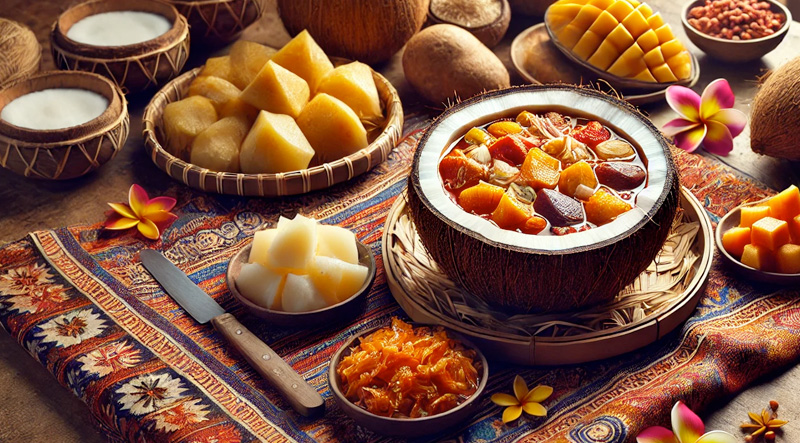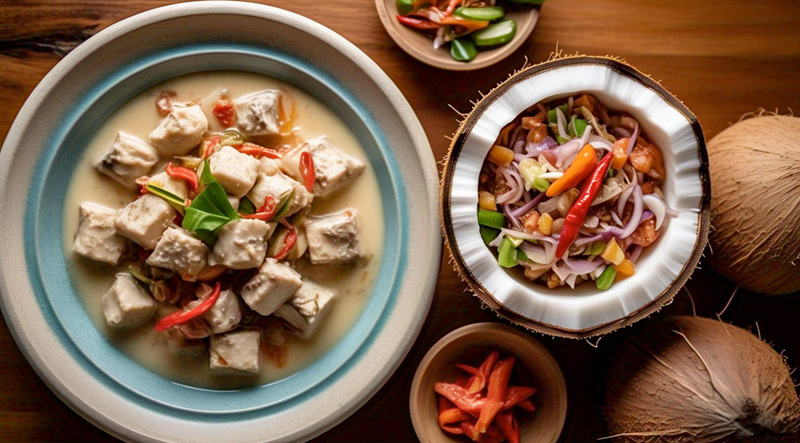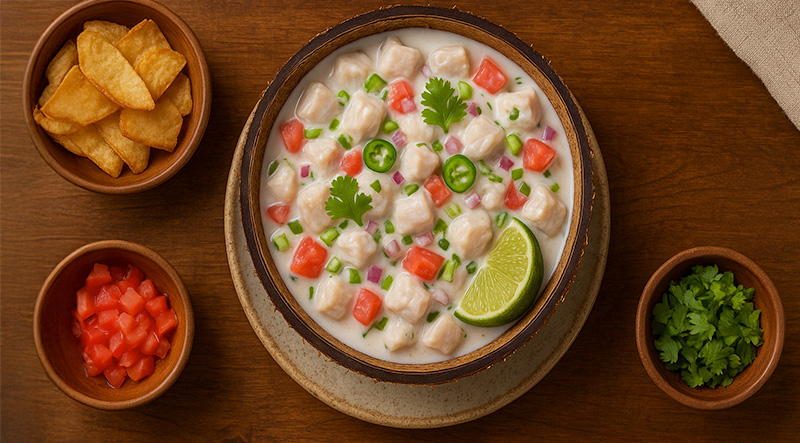Fresh, zesty, and bursting with island flavor, Kokoda is Fiji’s national dish and a true taste of the tropics. Made with tender cubes of raw fish marinated in tangy citrus juice, then soaked in rich, creamy coconut milk and tossed with chilies, onions, and tomatoes, Kokoda is a refreshing seafood delight. Served chilled—often in a coconut shell—it’s the perfect balance of cool, spicy, and savory, capturing the essence of Fiji’s coastal bounty in every spoonful. Whether you're relaxing on a beach or sharing a traditional Fijian feast, Kokoda is the dish that brings the islands to life. Read More...
The History of Kokoda – Fiji’s Fresh and Flavorful National Dish, A Taste of the Islands:
Kokoda (pronounced ko-kon-da) is more than just a dish—it’s a reflection of Fiji’s ocean-rich culture and love for bold, fresh flavors. As the national dish of Fiji, Kokoda embodies the country’s natural abundance and indigenous culinary traditions. This refreshing seafood salad, made with raw fish marinated in citrus juice and finished with creamy coconut milk, is a staple at both everyday meals and festive gatherings across the islands.
Ocean Origins:
The origins of Kokoda are closely tied to Fiji’s geography and lifestyle. As an archipelago in the South Pacific, Fiji’s communities have long relied on the ocean for sustenance. Fish, being plentiful and easily accessible, became a central part of the traditional Fijian diet. Long before refrigeration, Pacific islanders discovered that acidic citrus juice—from local limes or lemons—could preserve raw fish by “cooking” it in a chemical process called denaturation, much like heat does. This method, also found in other coastal cuisines like ceviche in Latin America or ika mata in the Cook Islands, allowed islanders to enjoy fish safely, even without cooking over fire.
The Coconut Connection:
What sets Kokoda apart from similar raw fish dishes around the world is the addition of rich, silky coconut milk. Coconut trees grow abundantly in Fiji and play a vital role in its cuisine. Grated coconut is pressed to extract milk, which is then used to mellow the acidity of the lime juice and create a creamy, luscious texture in Kokoda. This fusion of zesty and smooth flavors makes Kokoda uniquely Fijian and unmistakably tropical.
Evolution and Tradition:
Traditionally, Kokoda was prepared using reef fish like mahi-mahi, walu (Spanish mackerel), or snapper, diced and soaked in freshly squeezed lemon or lime juice. Once the fish turned opaque, it was combined with grated coconut, onion, tomato, chili, and salt. Today, modern versions may include cucumber, spring onion, coriander, or even a touch of ginger, but the soul of the dish remains the same—bright, clean, and deeply rooted in nature.
Kokoda is commonly served chilled in a bowl or coconut shell and is a popular feature at lovo feasts (traditional Fijian earth oven meals), weddings, national holidays, and resort menus catering to both locals and tourists. Its visual appeal—often garnished with herbs and lime wedges—adds to its festive presentation.
Global Influence, Local Pride:
As Fiji’s tourism grew in the 20th and 21st centuries, Kokoda gained popularity beyond local homes and into the global culinary spotlight. It is now a must-try item for visitors looking to experience authentic Fijian cuisine. Yet despite its global fame, Kokoda remains a dish that is prepared with love in village homes and coastal kitchens, keeping its identity intact.
A Dish that Tells a Story:
Kokoda is more than a meal—it is a culinary story of Fiji’s connection to the sea, its tropical environment, and its cultural creativity. It is a dish born from necessity and elevated by tradition, combining freshness with comfort. Every bite of Kokoda is a celebration of Fiji’s vibrant flavors, rich history, and the enduring bond between people and the ocean that sustains them.

Add Coconut Cream:

Chill and Serve:
Serve cold as a starter or light main dish, ideally with a side of boiled root vegetables, cassava chips, or simply on its own as a refreshing tropical delight.

Cassava (Tavioka) Fries Recipe – Fijian Side Dish for Kokoda:
The total preparation and cooking time for Kokoda is approximately 1 hour, including both active prep and marination. It takes about 15–20 minutes to dice the fish, chop the vegetables, and mix the ingredients. The fish then needs to marinate in citrus juice for 30–45 minutes, during which it "cooks" without heat by turning opaque and firm. Once drained and combined with coconut cream and seasonings, the Kokoda is chilled briefly before serving. Despite the short hands-on time, the result is a refreshing, flavor-packed dish perfect for warm weather or festive occasions.
A single serving of Kokoda, based on the provided recipe, contains approximately 300–350 calories. The lean white fish (about 100g per serving) contributes around 100–120 calories with high-quality protein and minimal fat. The rich coconut cream adds the majority of the calories—roughly 150–180 calories per serving—due to its healthy saturated fats. The remaining calories come from the diced vegetables, lime juice, and optional ingredients like cucumber or coriander, which are very low in calories. Overall, Kokoda is a nutrient-dense, refreshing dish that’s both satisfying and relatively light.







